Voter engagement in the presidential election remains quite high. And interest and motivation to vote is equally strong among registered voters who support Donald Trump and those who favor Joe Biden.
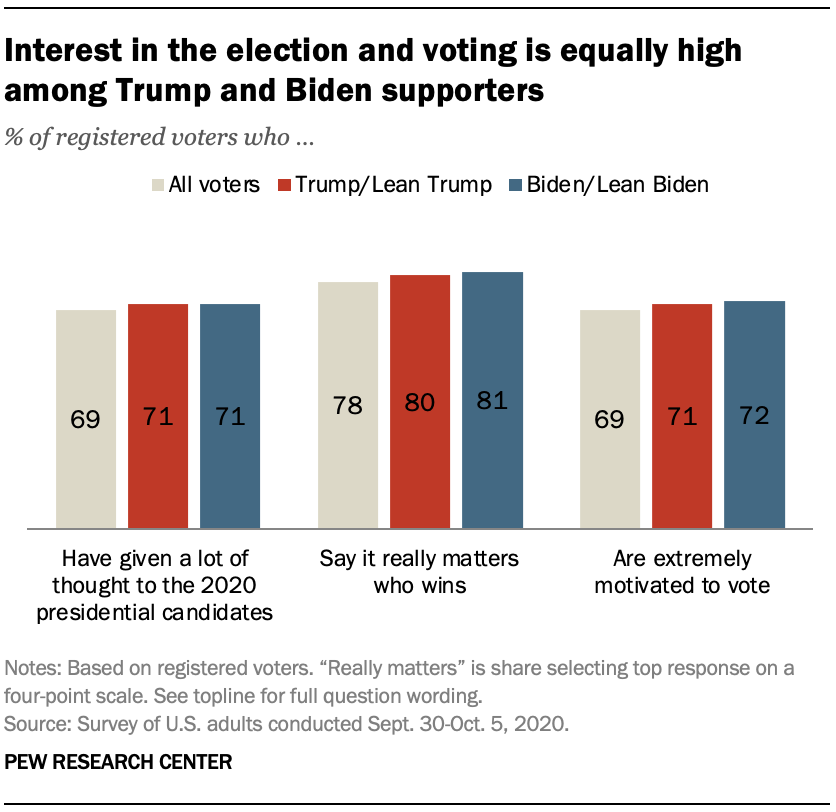
On three measures of interest in the campaign and voting, there are no significant differences between Trump and Biden supporters.
Roughly seven-in-ten Trump supporters (71%) say they have given “a lot” of thought to the candidates, identical to the share of Biden supporters (71%) who say this.
Similarly, 80% of Trump supporters and 81% of Biden supporters say it really matters who wins.
A large majority of all registered voters (69%) say they are extremely motivated to vote in the presidential election; another 18% say they are very motivated to vote while 8% say they are somewhat motivated. Just 5% of registered voters say they are not too motivated or not at all motivated to vote in the presidential election.
The shares of Trump and Biden supporters who say they are extremely motivated to vote also are strikingly similar: 71% of Trump supporters and 72% of Biden supporters say they are extremely motivated to cast ballots.
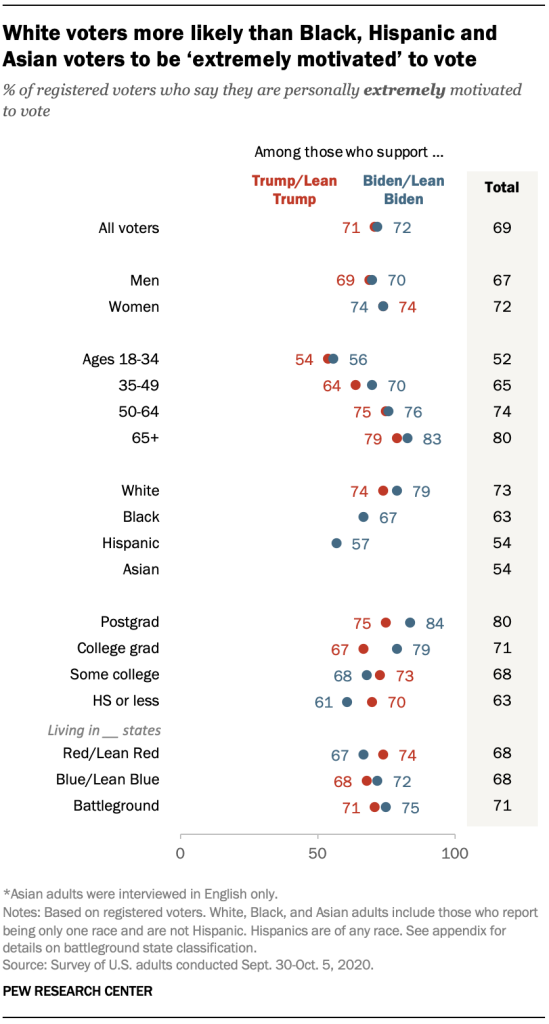
However, as in past elections, there are demographic differences in the shares expressing strong interest in voting. To some extent, these differences are seen in both electoral coalitions.
Young voters overall are less likely than older voters to say they are extremely motivated to vote in the presidential election. Only about half of registered voters ages 18 to 34 (52%) say they are extremely motivated to vote, compared with much larger shares of voters in older age categories.
Nearly equal shares of Trump (54%) and Biden supporters (56%) ages 18 to 34 say they are extremely motivated to vote. The shares expressing this view increase with age among both candidates’ supporters; roughly eight-in-ten Biden (83%) and Trump supporters (79%) ages 65 and older say they are extremely motivated.
About three-quarters of White voters (73%) say they are extremely motivated to vote, compared with 63% of Black voters and 54% of both Hispanic voters and Asian American voters (54%).
These racial and ethnic differences are seen among Biden supporters: While 79% of White Biden supporters say they are extremely motivated to vote, smaller majorities of Black (67%) and Hispanic (57%) voters who back Biden say the same.
Among voters overall, those with higher levels of formal education are more likely than those with less education to say they have a strong desire to vote. But these differences are much more pronounced among Biden than Trump supporters. For example, there is a 23 percentage point gap in the shares of Biden supporters with postgraduate degrees (84%) and those with no more than a high school education (61%) who say they are extremely motivated to vote. Among Trump supporters, there is just a 5-point difference between postgraduates and those with more than a high school degree.
Overall, registered voters report slightly higher levels of motivation to vote in battleground states (71% extremely motivated) than in either red or blue states (68% extremely motivated). In the battleground states, there is little difference in voter enthusiasm between the two camps, with 75% of Biden supporters and 71% of Trump supporters saying they are extremely motivated to vote.
Trump and Biden supporters differ on how they plan to vote
The vast majority of voters (90%) say they plan to vote in the coming month, while 7% say they have already cast their ballot for president. About four-in-ten registered voters (39%) say they plan to cast their vote by absentee or mail-in ballot this year (or already have done so), compared with 33% who say they plan to vote in person on Nov. 3, and 21% who have voted in person or plan to vote in person at an early voting location before Election Day.
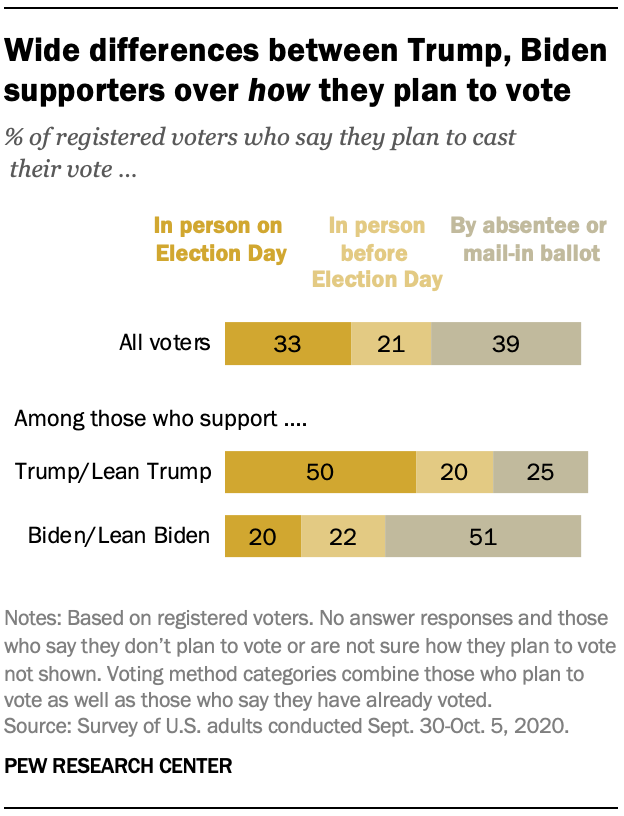
Trump supporters are more than twice as likely as Biden supporters to say they plan to vote in person on Election Day (50% vs. 20%). By contrast, 51% of Biden supporters say they plan to vote by mail or absentee (or have already voted this way). A quarter of Trump supporters (25%) say they plan to vote by mail or absentee.
In August, before general election voting had begun in any state, 60% of Trump supporters said they would prefer to vote in person on Election Day, compared with 17% who preferred to vote by mail. Among Biden supporters, 23% said they preferred to vote in person on Election Day and 58% said they preferred to vote by absentee or mail-in ballot.
Among all registered voters, 6% say that this year is the first election year in which they are voting.
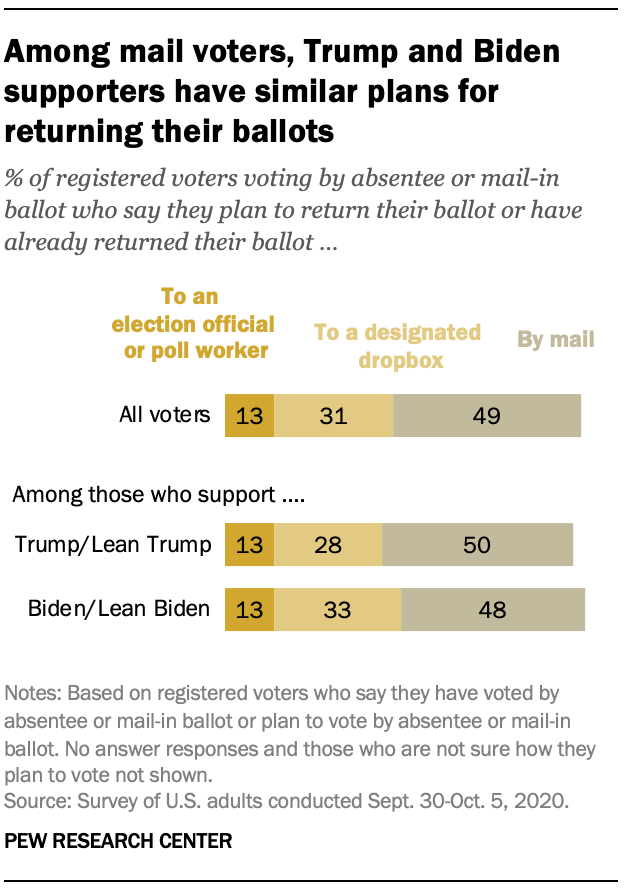
Despite ongoing concerns about the U.S. Postal Service’s ability to deliver ballots in a timely manner this fall, nearly half of those voting by mail or casting an absentee ballot (49%) say they intend to return their ballots by mail or have already returned their ballot by mailing it in.
About three-in-ten (31%) of those voting by absentee or mail-in ballot have returned or plan to return their ballot to a designated drop box, and 13% have returned their ballot to an election official or poll worker or plan to return their ballot this way.
The shares of Trump supporters and Biden supporters who plan to return an absentee or mail-in ballot by mail are nearly identical, though Biden supporters are slightly more likely to say they plan to return their ballot to a drop box than Trump supporters.
The methods by which voters have cast their votes or plan to cast their votes vary by age and race and ethnicity in addition to candidate preference.
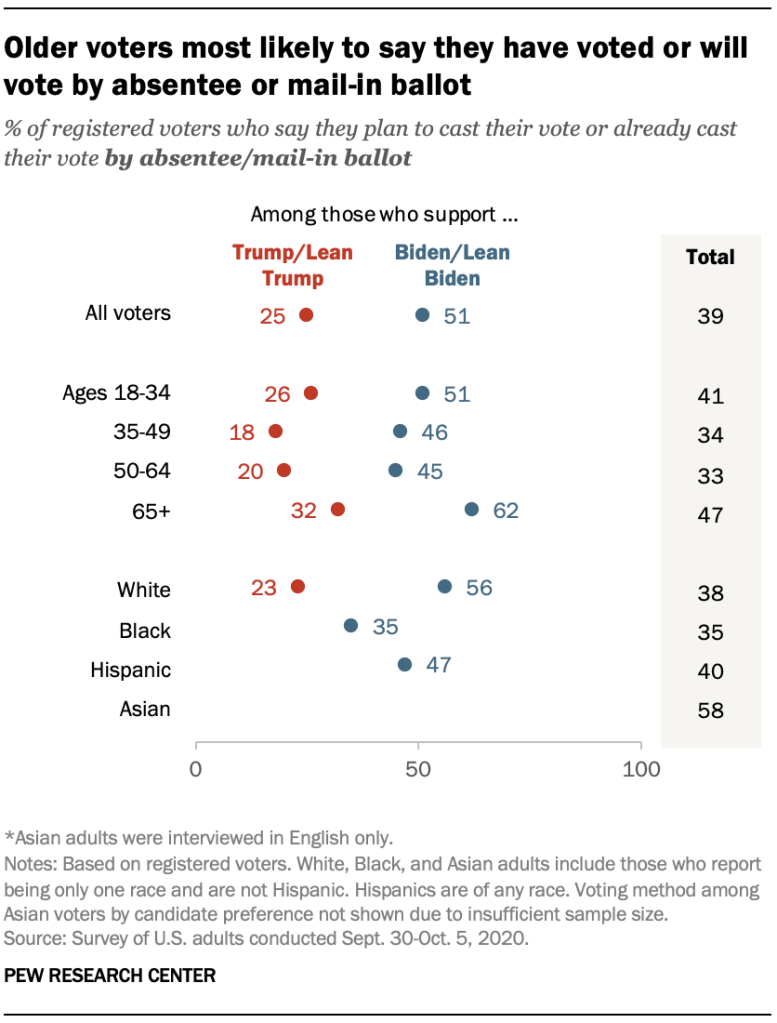
Voters age 65 and older are more likely than those in other age groups to say they have or will cast their vote by absentee or mail-in ballot, with 47% of those 65 and older saying this. That compares with 41% of younger voters (those ages 18 to 34) and about a third of those ages 35 to 64.
Across all age categories, Biden supporters are more likely than Trump supporters to say they have voted or will vote by absentee or mail-in ballot.
Among Biden supporters, White voters are 9 percentage points more likely than Hispanic voters to say they have voted or will vote by mail or absentee, and 21 points more likely than Black voters to say this.
These differences can be partly explained by the fact that Black voters are more likely to live in states with stricter requirements for voting by mail. However, differences persist even after accounting for the geographic distribution of voters.




